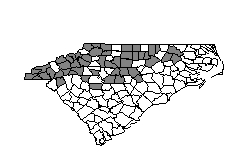![]()
<< Back :: Virginia :: North Carolina :: South Carolina :: Georgia :: FWGNA Home ::
![]()
<< Back :: Virginia :: North Carolina :: South Carolina :: Georgia :: FWGNA Home ::
> Ferrissia rivularis (Say
1817)
>Habitat & Distribution
F. rivularis ranges throughout North America, being found attached to
rocks, cobbles, macrophytes, leaves, woody debris, pop bottles and beer cans in
rivers, streams, and northern lakes. It
seems to require well-oxygenated water, and is especially characteristic of
low-nutrient streams with good water quality. In the southern Atlantic
drainage it does not occur in swamps or lentic environments generally, seeming
to require at least low levels of flow.
> Ecology & Life history
This little limpet was one of the most herbivorous of the macrobenthos studied
by Coffmann (1971) dining almost entirely upon diatoms (Blinn et al. 1989).
It shows great variation in life cycle, Burky (1971) reporting a simple annual
life cycle in one population and two generations per year in a second. Jokinen
(1985) reported three generations per year for a Ferrissia population in
Connecticut (Life cycle Esis). Generation times of less than six weeks have been documented in the laboratory (Dillon & Herman 2009).
The statewide distribution of Ferrissia
in Connecticut reported by Jokinen (1983) suggested to Dillon (2000: 360-363)
that the species might show Stress-tolerant life history
adaptation. But both of Burky’s
populations posted reproductive efforts in line with their adult sizes,
suggesting that they are Undifferentiated in their life history strategy
(Dillon 2000: 126-135).
The allozyme data of Dillon & Herman (2009) suggest that
Ferrissia populations may be obligately self-fertilizing.
Self fertilization has been well-documented in the European freshwater
limpet Ancylus fluviatilis (Stadler et al. 1995).
> Taxonomy & Systematics
Basch (1963) recognized five species in the genus Ferrissia - F. rivularis from
stones, F. fragilis from vegetation and organic debris in flowing water, F.
parallela on narrow-bladed plants in lentic environments, F. walkeri on
broad-leaved plants in lentic environments, and F. mcneilli endemic to
Alabama. Walther (pers. comm.) combined
these taxa into two lineages, broadly correlated with the rivularis and
fragilis morphologies and life habits, on the basis of DNA sequence data. Dillon & Herman (2009) reported that all the morphological
criteria by which fragilis and rivularis have been distinguished seem to be the
result of ecophenotypic plasticity (Russell-Hunter et al. 1967), unifying all the American Ferrissia under the single nomen F. rivularis. See Essay #1 below.
> Maps of Ferrissia distribution
Click the small map to enlarge
it, or download the state-specific PDFs

North Carolina (PDF)
South Carolina (PDF)
Georgia (PDF)
> References
Basch, P. (1963) A review
of the recent freshwater limpet snails of North America. Bull. Mus.
Comp. Zool. Harvard, 129, 399-461. Blinn, D., R. Truitt, & A. Pickart. (1989) Feeding ecology and radular morphology of the freshwater limpet Ferrissia fragilis. J. N. Am. Bentho. Soc., 8: 237-242.
Burky, A. (1971) Biomass turnover, respiration, and
interpopulation variation in the stream limpet Ferrissia rivularis (Say). Ecol.
Monog., 41: 235-251. Coffman, W.
(1971) Energy flow in a woodland stream ecosystem: I.
Tissue support trophic structure of the autumnal community. Arch.
Hydrobiol., 68: 232-276. Dillon,
R. T., Jr. (2000) The Ecology of Freshwater
Molluscs. Cambridge University Press, United Kingdom. 509
pp. Dillon, R. T., & J. J. Herman (2009) Genetics, shell morphology, and life history of the freshwatear pulmonate limpets Ferrissia rivularis and Ferrissia fragilis. J. Freshwat. Ecol. 24: 261 - 271. Hubendick, B. (1964)
Studies on Ancylidae, The subgroups. Meddelanden Fran Goteborgs
Musei Zoologiska Avendelining, 137. (Goteborgs Kungl.
Vetenskaps-Och Vitterhets-Samhalles Handlingar. Sjatte Foljden.
Ser. B.) 9, 1-72. Jokinen, E. (1983) The freshwater snails of Connecticut. Hartford, Connecticut, State Geol. Nat. Hist. Survey Bull. 109. 83 p. Jokinen, E. (1985)
Comparative life history patterns within a littoral zone snail
community. Verh. Internat. Verein, Limnol., 22: 3292-3399. Keating, S.T.
& Prezant, R.S. (1998) Effects of stream chemistry on
the distribution, growth, and diatom colonization of the freshwater
limpet, Ferrissia rivularis.
J. Freshwat. Ecol. 13: 67-77.
Russell-Hunter, W.D., M. L. Apley, A. J. Burky, & R. T. Meadows
(1967) Interpopulation variations in calcium metabolism in
the stream limpet, Ferrissia
rivularis (Say) Science 155: 338-340. Russell-Hunter, W.D., Burky, A.J.
& Russell-Hunter, R.D. (1981) Interpopulaton Variation
in Calcareous and Proteinaceous Shell Components in the Stream Limpet, Ferrissia rivularis.
Malacologia 20: 255-266. Stadler, T., S. Weisner, & B. Streit (1995)
Outcrossing rates and correlated matings in a predominantly selfing
freshwater snail. Proc. R. Soc. Lond. B 262: 119-125. Walther, A. C., T. Lee, J. B. Burch, and D. O'Foighil (2006) Confirmation that the North American ancylid Ferrissia fragilis (Tryon 1863) is a cryptic invader of European and East Asian freshwater ecosystems. J. Moll. Stud. 72: 318 - 321.
Robert T. Dillon, Jr.
Department of Biology, College of
Charleston
Charleston, SC 29424
P: 843.953.8087
F: 843.953.5453